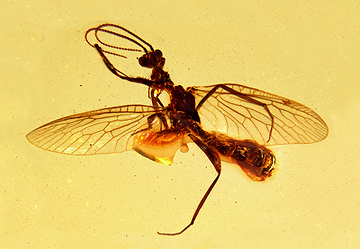Abstract
Three new early Barremian amber outcrops are reported from Mazraat Kfardibiane (Caza Kesserouane, Central Lebanon), among which one (Red Rock area) yielded two biological inclusions and increasing as such the Lower Cretaceous Lebanese amber outcrops with fossil biological inclusions to 24. The amber from these newly discovered outcrops is described, characterized, and chemically analysed using Fourier Transform Infrared (FT-IR) spectroscopy.
References
Azar, D. (1997) A new method for extracting vegetal and insect fossils from the Lebanese amber. Palaeontology, 40, 1027– 1029.
Azar, D. (2007) Preservation and accumulation of biological inclusions in Lebanese amber and their significance. Comptes Rendus Palevol, 6, 151–156.
https://doi.org/10.1016/j.crpv.2006.10.004
Azar, D. (2012) Lebanese amber: a “Guinness Book of Records”. Annales Universitatis Paedagogicae Cracoviensis, 111, 44– 60.
Azar, D., Gèze, R. & Acra, F. (2010a) Chapter 14: Lebanese amber. In: Penney, D. (Ed.), Biodiversity of fossils in amber from the major world deposits, pp. 271–298, Siri Scientific Press, Manchester.
Azar, D., Gèze, R., El-Samrani, A., Maalouly, J. & Nel, A. (2010b) Jurassic amber in Lebanon. Acta Geologica Sinica—English Edition, 84, 977–983.
https://doi.org/10.1111/j.1755-6724.2010.00228.x
Azar, D. & Nel, A. (1998) Lebanese Lower Cretaceous amber. Meganeura, 2, 18–20.
Dubertret, L. (1945) Carte géologique au 50.000ème—Feuille de Zahlé. République Libanaise, Ministère des Travaux Publics, Beyrouth, 64 pp. + 13 pls. + map.
Dubertret, L. & Wetzel, R. (1945) Carte géologique au 50.000ème—Feuille de Qartaba. République Libanaise, Ministère des Travaux Publics, Beyrouth, 56 pp. + 12 pls. + map.
Granier, B., Azar, D., Maksoud, S., Gèze, R. & Habchi, R. (2015) New fossiliferous sites with Barremian Charophyta in the «Grès du Liban» auct. (Lebanon), with a critical perspective regarding the nature of Munieria Deecke, 1883. Carnets de Géologie, 15 (15), 199–229.
https://doi.org/10.4267/2042/57947
Granier, B., Toland, C., Gèze, R., Azar, D. & Maksoud, S. (2016) Some steps toward a new story for the Jurassic–Cretaceous transition in Mount Lebanon. Carnets de Géologie, 16 (8), 247–269.
https://doi.org/10.4267/2042/59924
Maksoud, S. & Azar, D. (2020) Lebanese amber: latest updates. Palaeoentomology, 3 (2), 125–155.
https://doi.org/10.11646/palaeoentomology.3.2.2
Maksoud, S., Azar, D, Granier, B. & Gèze, R. (2017) New data on the age of the Lower Cretaceous amber outcrops of Lebanon. Palaeoworld, 26 (2), 331–338.
https://doi.org/10.1016/j.palwor.2016.03.003
Maksoud, S., Granier, B., Azar, D., Gèze, R., Paicheler, J.-C. & Moreno-Bedmar, J.A. (2014) Revision of “Falaise de BLANCHE” (Lower Cretaceous) in Lebanon, with the definition of a Jezzinian Regional Stage. Carnets de Géologie, 14 (18), 401–427.
https://doi.org/10.4267/2042/54359
Maksoud, S., Taleb, K. & Azar, D. (2019) Four new Lower Barremian amber outcrops from Northern Lebanon. Palaeoentomology, 2 (4), 333–339.
https://doi.org/10.11646/palaeoentomology.2.4.6
Nohra, Y., Azar, D., Gèze, R., Maksoud, S., El-Samrani, A. & Perrichot, V. (2013) New Jurassic outcrops from Lebanon. Terrestrial Arthropod Reviews, 6, 27–51.
https://doi.org/10.1163/18749836-06021056
Poinar, G.O. Jr. (2003) Amber. In: Resh, V.H. & Cardé, R.T. (Eds), Encyclopedia of insects, Academic Press, [Amsterdam], pp. 9–12.
Poinar, G.O. Jr. & Milki, R. (2001) Lebanese amber: the oldest insect ecosystem in fossilized resin. Oregon State University Press, Corvallis, Oregon, 96 pp.
Sargent Bray, P. & Anderson. K.B. (2009) Identification of Carboniferous (320 million years old) class Ic amber. Science, 326, 132–134.
https://doi.org/10.1126/science.1177539
Schmidt, A.R., Jancke, S., Lindquist, E.E., Ragazzi, E., Roghi, R., Nascimbene, P.C., Schmidt, K., Wappler, T. & Grimaldi, D.A. (2012) Arthropods in amber from the Triassic period. Proceedings of the National Academy of Sciences of the United States of America, 109, 14796–14801.


